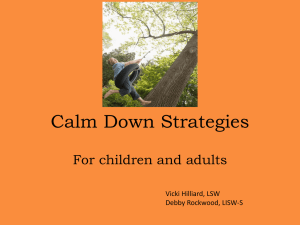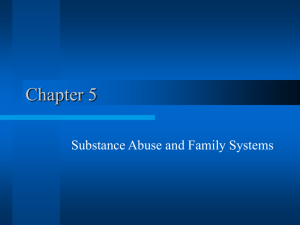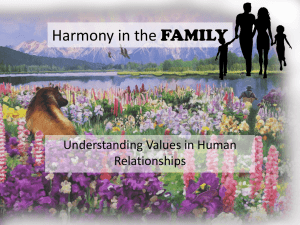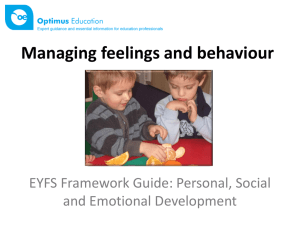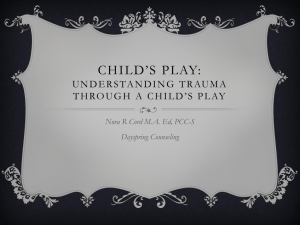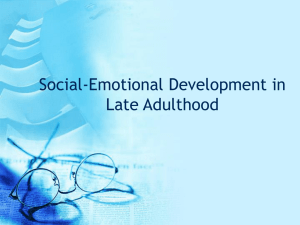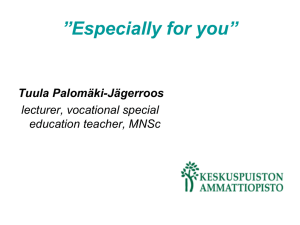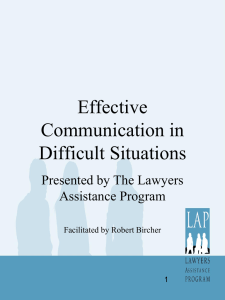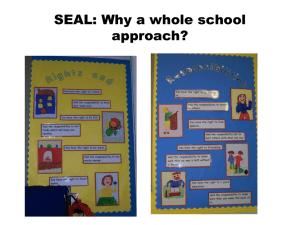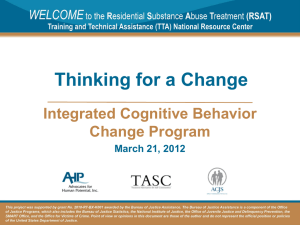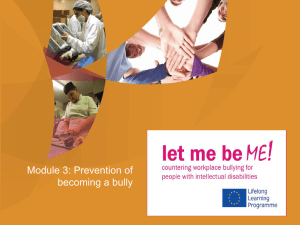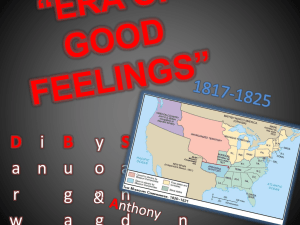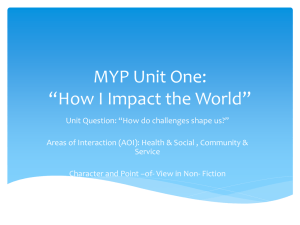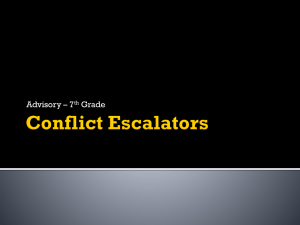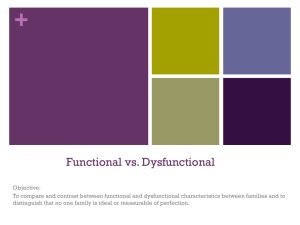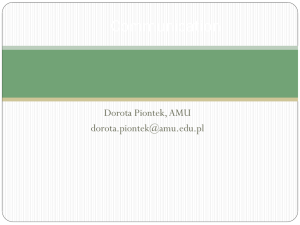SUBSTANCE ABUSE AND FAMILY SYSTEMS
advertisement
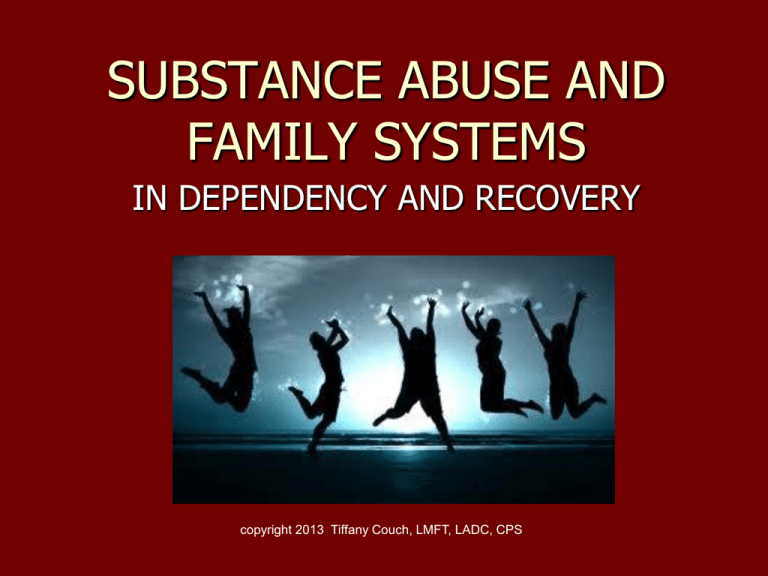
SUBSTANCE ABUSE AND FAMILY SYSTEMS IN DEPENDENCY AND RECOVERY copyright 2013 Tiffany Couch, LMFT, LADC, CPS Families can be seen as systems. They all have: Rules Values Verbal and nonverbal methods of communication Boundaries Roles Patterns of interaction Substance dependency causes dysfunction in the family Looking at the family as a system it is VERY IMPORTANT to address the problem of substance abuse and dependency!! If the family system does not change and family members do not do their own recovery work… the styles of communication and interaction don’t change and those old interactions put the alcoholic/addict at risk for relapse! Reasons families may be resistant to treatment: Too often the alcoholic/addict is the focus of treatment…”just fix him and we’ll be okay.” Family members resist looking at their own behaviors and painful feelings. Fear that the family system won’t survive, that it’s damaged beyond repair. Family Rules Family rules often involve rules of communication – Who is allowed to express feelings – How and when they are expressed – How they are received The rules of the dysfunction family are: DON’T TALK DON’T TRUST DON’T FEEL Don’t Talk Talking about the problem will only make it worse It’s the family secret and is NEVER mentioned to anyone outside the family Nothing is going to change so why bother Don’t Trust Trusting will only lead to disappointment You don’t trust what you hear or what you see Promises are made to be broken Don’t Feel Feelings are for wimps Feelings are too painful Expression of painful feelings is not allowed because it might cause more problems DYSFUNCTIONAL FAMILY SYSTEMS Rigid family system Ambiguous family system Overextended family system Distorted family system As each is addressed, see if you identify with a particular system. RIGID FAMILY SYSTEM RULES – Strict rules with no exceptions. The rule keeper is exempt from the rules. VALUES – It’s my way or the highway. Things are right or wrong, black or white. MOTTO – Do it right or else! COMMUNICATION – From the top down, only. AMBIGUOUS FAMILY SYSTEM RULES – We have rules but we don’t enforce them. VALUES – Ever changing, based on the situation. MOTTO – Avoid conflict at all costs. COMMUNICATION – Mixed messages that are confusing. OVEREXTENDED FAMILY SYSTEM RULES – Be productive, get busy, stay on the move. VALUES – Look good, achieve through willpower, no time for feelings. MOTTO – We can achieve anything! COMMUNICATION – Whatever is pleasing to the parents. DISTORTED FAMILY SYSTEM RULES – Don’t let outsiders know we’re crazy, act normal. VALUES – Maintain illusion of normalcy despite all the problems. MOTTO – Aren’t most families like ours? COMMUNICATION – Mixed messages, most family members unavailable. Communication within the dysfunctional family is often: Confusing Threatening From the top down Has double messages The different types of communication styles are: Placater Discount themselves. Their goal is to avoid conflict and to avoid other’s anger. Use words of agreement: “whatever you want is okay with me.” Body language is of being submissive. Feelings are of being worthless. Blamer Elevate themselves by discounting others. Use words that are critical: “you can’t do anything right!” Body language is of being more powerful and dominant. Feelings are that is other people’s fault they are unhappy. Intellectualizer Goal is to place rigid emphasis on the cognitive to figure out problems. Use words that extremely logical: that makes sense and is reasonable. Body language is of being in control. Feelings are avoided… it’s the thinking that’s important. Distracter Goal is to keep others and themselves away from painful feelings. Use words that are confusing and irrelevant to the situation. Body language is of being somewhere else Feelings are avoided because they may cause pain. LEVELING Leveling is the healthy state of communication. Words, body language, and feelings match the message. FAMILY SYSTEM ROLES These roles are labeled in terms of the coping mechanisms family members use to survive in the dysfunctional family system. These roles are illustrations of dysfunctional patterns and are not used to “diagnose”. Victim/Addict Hostile Manipulative Aggressive Blaming Self- pity Charming Rigid CHIEF ENABLER Assumes primary responsibility for the chemically dependent person Protects, shelters, and even denies the problem Attempts to control, takes over responsibility, rationalizes and accepts HERO The achiever, the good child, the model child The family can point to this child and say “we don’t have problems, just look at him/her” Family’s self-worth is tied to this child’s accomplishments SCAPEGOAT Their primary function is to divert the families attention from the real problem Family member can blame the scapegoat for all their problems Often exhibits acting out behaviors in school, at home, and displays anti-social behavior LOST CHILD Often the most tragic Role is to allow the family to expend less energy Family reinforces this child for not having “needs” Frequently disconnects emotionally MASCOT Primary role is to divert attention away from the family issues and pain Uses humor, silliness, and even making fun of him/herself Often denies a sense of self and may feel unworthy unless they can alleviate pain STAGES IN FAMILY RECOVERY The stages of grieving can also be used to describe the stages of recovery: Denial Anger Bargaining Feeling Acceptance Denial Family members rarely acknowledge something is wrong May seek help in an indirect, nonspecific way Friends and relatives often reinforce the denial Anger Effective defense to keep family members from talking about the real problem Can involve actual or threatened abandonment or rejection Used by the dependent person to avoid feelings of shame Family members may reach out beyond relatives but information continues to be vague or minimized Bargaining Usually follows a major crisis Family can no longer deny that there is a problem Family still not ready to effect real change so tries to “buy” their way out Family members may reach out to professionals but are not really ready to follow through Feeling Family member can no longer deny, cover with anger, or bargain their feelings away Family members become anxious and hyper-vigilant Intense feelings force family members to seek help Acceptance Family members recognize the problem for what it really is They are ready to do work necessary to heal Recognizing that all are suffering, they have the courage to get help This is where treatment and recovery begin The End Copyright 2013 Tiffany Couch, LMFT, LADC, CPS
